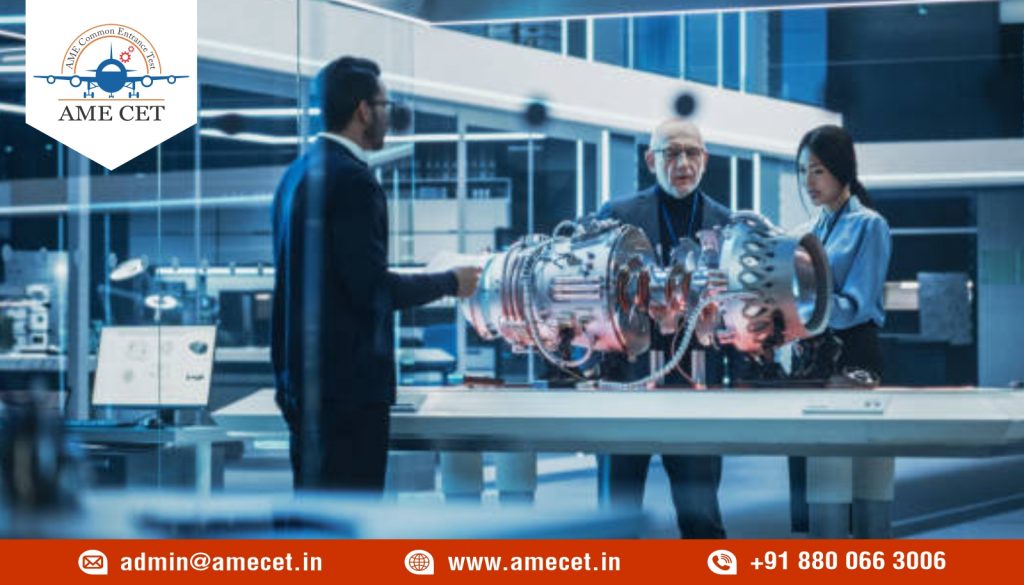What is the difference between AME DGCA license and AME EASA license?
Posted on : 9 January, 2024 5:08 pm
Aircraft Maintenance Engineer (AME) licenses play a crucial role in ensuring the safety and airworthiness of aircraft. Two major regulatory bodies, DGCA (Directorate General of Civil Aviation) in India and EASA (European Union Aviation Safety Agency) in the European Union, govern these licenses. It’s crucial for students who wants to enter the field of aviation maintenance in these regions to understand the differences between AME DGCA and AME EASA.
What is the regulatory body for an AME License?
The Aircraft Maintenance Engineering (AME) License is governed by different regulatory bodies depending on the region. In India, the Directorate General of Civil Aviation (DGCA) oversees the issuance of AME licenses. The DGCA sets standards for training, conducts examinations, and ensures compliance with international aviation norms. It’s the key authority for those looking to work within India’s aviation sector.
DGCA (Directorate General of Civil Aviation)
In India, the Directorate General of Civil Aviation (DGCA) oversees the issuance of AME licenses. The DGCA sets standards for training, conducts examinations, and ensures compliance with international aviation norms. It’s the key authority for those looking to work within India’s aviation sector.
- DGCA is the regulatory body for civil aviation in India.
- AME DGCA refers to the Aircraft Maintenance Engineer license issued by the DGCA in India.
- The training and certification process for AME DGCA is governed by the regulations and requirements set by the DGCA in India.
EASA (European Union Aviation Safety Agency)
European Union Aviation Safety Agency (EASA) is the central body responsible for civil aviation safety in Europe. An EASA license has wide recognition in European countries and is valued by airlines operating within and in association with Europe. EASA sets stringent standards for maintenance practices, and its license is recognized globally for its high quality.
- EASA is the regulatory body for civil aviation safety in the European Union (EU).
- AME EASA refers to the Aircraft Maintenance Engineer license issued by EASA.
- EASA has established common regulations for the certification of personnel and aircraft across its member states. The AME EASA license follows these EASA regulations.
Key Differences between AME DGCA and EASA License:
Geographical Scope:
-
- AME DGCA is specific to India and regulated by the DGCA.
AME EASA is applicable in the European Union member states and adheres to the regulations set by EASA.
Regulatory Framework:
- AME DGCA follows the regulations and guidelines set by the DGCA in India.
- AME EASA follows the common regulations established by EASA for its member states.
International Recognition:
- AME EASA may have broader international recognition, especially within the European aviation industry and countries that accept EASA certifications.
- AME DGCA is primarily recognized within India and may have different recognition levels internationally.
Training and Certification Standards:
- The training and certification standards for AME DGCA are set by the DGCA in India.
- The training and certification standards for AME EASA are set by EASA, providing a standardized approach across EU member states.
Examination and Licensing Process:
- AME DGCA: The examination process for DGCA licensing typically involves written exams, practical assessments, and an oral test. The process is specific to India, focusing on regulations and practices prevalent in the Indian aviation sector.
- AME EASA: EASA’s licensing process is known for its stringent standards, involving comprehensive theoretical exams and practical assessments that adhere to a uniform standard across all EU member states. This process ensures a high level of proficiency and knowledge that is consistent throughout Europe.
Career Opportunities:
- AME DGCA: Holders of an AME license from DGCA are primarily eligible for employment within the Indian aviation industry, including domestic airlines, maintenance, repair, and overhaul (MRO) organizations, and various aviation-related agencies in India.
- AME EASA: An EASA license opens doors to a wider range of career opportunities in various European countries and in international airlines and organizations that recognize or require EASA certification.
Currency and Conversion:
- AME DGCA: Converting a DGCA license to other international standards can be a complex process and might require additional training or examinations, depending on the region.
- AME EASA: EASA licenses are often more easily convertible to other international standards due to their widespread recognition. This makes them more flexible for AMEs who wish to work in different countries.
Regulatory Updates and Compliance:
- AME DGCA: DGCA regulations are subject to changes made by the Indian government and aviation authorities, which can influence the scope and practices within the country’s aviation sector.
- AME EASA: EASA regularly updates its regulations to comply with the latest international aviation standards and technological advancements, ensuring a high level of safety and efficiency.
Specializations and Modules:
-
- AME DGCA: The DGCA curriculum may have specific modules and specializations tailored to the needs and demands of the Indian aviation industry.
- AME EASA: EASA provides a wide range of specialized modules, allowing for deeper expertise in various aspects of aircraft maintenance, in line with international practices.
In simpler terms, the main difference between AME DGCA and AME EASA is all about where you want to work with airplanes and who gives you the license. If your dream is to work with airplanes in India, you need to get an AME DGCA license. The DGCA is like the boss in India who sets the rules for aviation. On the other hand, if you dream of working with airplanes in countries that are part of the European Union, then you need an AME EASA license.

